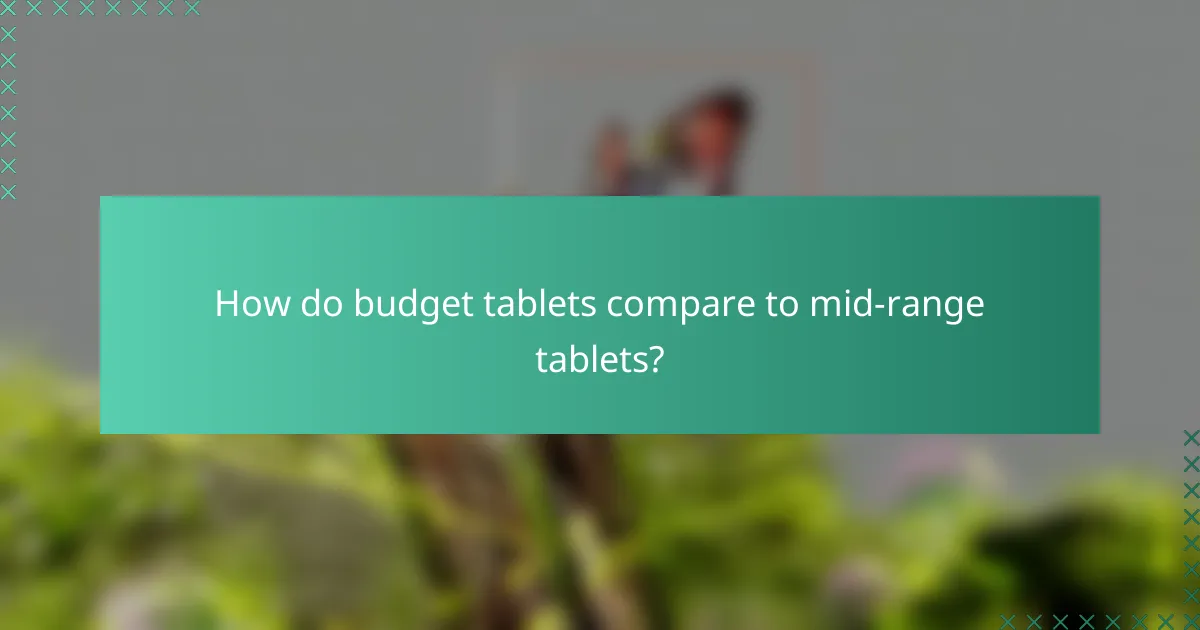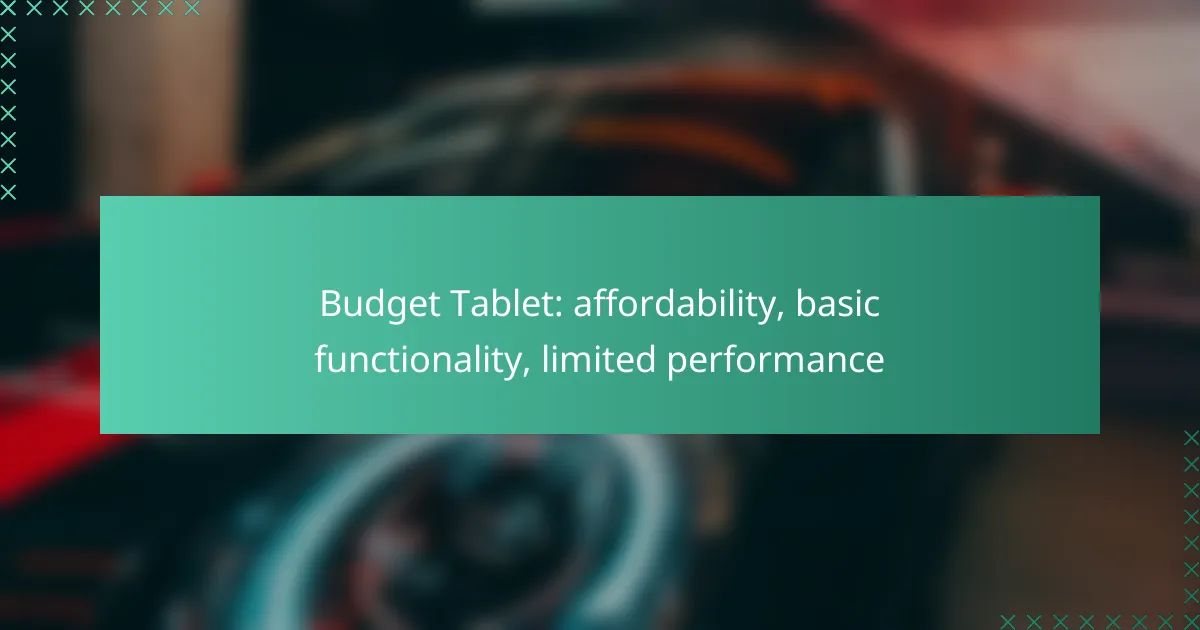Budget tablets provide an affordable option for users seeking basic functionality without breaking the bank. Priced between NZD 200 and NZD 600, these devices are ideal for everyday tasks such as browsing, streaming, and light productivity, though they may have limitations in performance compared to more premium models.

What are the best budget tablets in New Zealand?
The best budget tablets in New Zealand offer a balance of affordability, basic functionality, and limited performance suitable for everyday tasks. These devices typically range from NZD 200 to NZD 500, making them accessible for casual users who need a reliable tablet for browsing, streaming, and light productivity.
Samsung Galaxy Tab A8
The Samsung Galaxy Tab A8 is a popular choice for budget-conscious consumers, featuring a 10.5-inch display and solid build quality. It runs on Android, providing access to a wide range of apps and services, making it suitable for both entertainment and productivity.
With a battery life of around 10 hours, it can easily handle daily tasks like web browsing and video streaming. However, its performance may lag with more demanding applications, so it’s best for users with basic needs.
Lenovo Tab M10 Plus
The Lenovo Tab M10 Plus offers a 10.3-inch Full HD display, making it great for watching videos and reading. It comes with a decent processor and up to 4GB of RAM, allowing for smooth multitasking within its limits.
This tablet also features dual speakers with Dolby Atmos, enhancing the audio experience. While it performs well for casual use, heavy gaming or multitasking may lead to slower performance.
Amazon Fire HD 10
The Amazon Fire HD 10 is an affordable option with a 10.1-inch display and a user-friendly interface. It is particularly well-suited for Amazon Prime members, providing easy access to streaming services and content.
With a battery life of up to 12 hours, it is ideal for long usage sessions. However, it runs on a modified version of Android, which limits access to some apps available on the Google Play Store.
Huawei MatePad T10s
The Huawei MatePad T10s features a 10.1-inch display and a powerful sound system, making it a good choice for media consumption. It runs on Huawei’s EMUI, which offers a smooth user experience, though it lacks Google services due to trade restrictions.
Despite this limitation, it provides solid performance for basic tasks and has a battery life of around 12 hours. Users should consider whether they can adapt to the absence of certain apps before purchasing.
Lenovo Tab P11
The Lenovo Tab P11 stands out with its 11-inch display and optional keyboard support, making it a versatile choice for both entertainment and productivity. It offers a good balance of performance with its Snapdragon processor and up to 6GB of RAM.
While it is slightly higher in price compared to other budget options, its capabilities make it a worthwhile investment for users who need more functionality without breaking the bank. Battery life is competitive, lasting up to 15 hours on a single charge.

How much do budget tablets cost in New Zealand?
Budget tablets in New Zealand typically range from NZD 200 to NZD 600, offering a balance between affordability and basic functionality. These devices are designed for everyday tasks such as browsing, streaming, and light productivity.
Price range from NZD 200 to NZD 600
The price range for budget tablets in New Zealand generally starts around NZD 200 for entry-level models and can go up to NZD 600 for those with better specifications. At the lower end, you can expect basic features suitable for casual use, while the higher end may include improved displays and performance capabilities.
When shopping for a budget tablet, consider what features are essential for your needs. For instance, if you primarily use it for reading or streaming, a model on the lower end may suffice. However, for multitasking or more demanding applications, investing closer to NZD 600 could be beneficial.
Average cost of popular models
The average cost of popular budget tablet models in New Zealand tends to hover around NZD 400. This price point often includes well-known brands that provide reliable performance and decent build quality.
Some popular models within this average range include the Samsung Galaxy Tab A and the Lenovo Tab M10. These tablets typically offer a good balance of features, such as decent battery life and acceptable processing power, making them suitable for most users.

What are the key features of budget tablets?
Budget tablets typically offer essential functionality at an affordable price, making them suitable for basic tasks like browsing, streaming, and light productivity. However, they often come with limitations in performance and features compared to higher-end models.
Display size and resolution
Budget tablets usually feature display sizes ranging from 7 to 10 inches, which strikes a balance between portability and usability. The resolution often falls between 800×1280 and 1200×1920 pixels, providing adequate clarity for reading and watching videos.
When selecting a budget tablet, consider how you will use the display. A larger screen may enhance your viewing experience, but it can also make the device bulkier and less portable.
Battery life
Battery life in budget tablets typically ranges from 5 to 10 hours, depending on usage and specific models. This duration is generally sufficient for casual browsing or watching a few episodes of your favorite show.
To maximize battery life, avoid running multiple apps simultaneously and reduce screen brightness. Regularly updating the operating system can also help improve efficiency.
Storage capacity
Most budget tablets come with storage options between 16GB and 64GB, which may be expandable via microSD cards. While this is adequate for basic apps and some media, heavy users may find it limiting.
Consider your storage needs before purchasing. If you plan to download many apps or store large files, opt for a model with higher built-in storage or ensure it supports expandable memory.
Operating system
Budget tablets often run on Android or a simplified version of Windows, with some models using proprietary systems. Android tablets typically offer a wider range of apps and customization options compared to their Windows counterparts.
Choose an operating system that aligns with your needs. If you prefer a familiar interface and access to a vast app ecosystem, an Android tablet may be the better choice.

What are the limitations of budget tablets?
Budget tablets often come with several limitations that affect their overall usability and performance. While they provide basic functionality at an affordable price, users may encounter issues related to performance, app compatibility, and build quality.
Performance constraints
Budget tablets typically have lower processing power and memory compared to higher-end models. This can result in slower performance, especially when multitasking or running demanding applications.
Users may experience lag or delays when opening apps or switching between tasks. For basic tasks like browsing the web or streaming videos, this might be acceptable, but it can hinder productivity for more intensive activities.
Limited app compatibility
Many budget tablets run on less powerful operating systems, which can restrict the types of apps available for download. Some popular applications may not be supported, limiting the device’s functionality.
Before purchasing a budget tablet, check the compatibility of essential apps you plan to use. This ensures that the device will meet your needs without unexpected limitations.
Lower build quality
Budget tablets often use cheaper materials, which can affect their durability and lifespan. Users may find that these devices are more prone to physical damage or wear and tear over time.
When considering a budget tablet, look for reviews that mention build quality. Investing in a protective case can also help prolong the device’s life, but it adds to the overall cost.

What should you consider when choosing a budget tablet?
When selecting a budget tablet, prioritize affordability, basic functionality, and acceptable performance for your needs. Consider how you plan to use the device, the brand’s reliability, and insights from customer reviews to make an informed choice.
Usage requirements
Identify your primary use cases for the tablet. If you need it for browsing, streaming, or light productivity tasks, a budget tablet can suffice. However, for more demanding applications like gaming or graphic design, you may need to invest in a higher-end model.
Think about the operating system as well. Android and iOS tablets offer different app ecosystems, which can affect your experience based on the apps you need. Ensure the tablet supports the software you intend to use.
Brand reputation
Brand reputation plays a significant role in the reliability and longevity of a budget tablet. Established brands often provide better customer support and warranty options, which can be crucial if you encounter issues.
Research brands known for their budget offerings, such as Samsung, Lenovo, and Amazon. These companies typically have a track record of producing affordable devices that meet basic functionality needs.
Customer reviews
Customer reviews can provide valuable insights into the real-world performance of budget tablets. Look for feedback on aspects like battery life, display quality, and overall usability to gauge whether a device meets your expectations.
Pay attention to common themes in reviews, such as durability or software updates. A tablet that receives consistent praise for its longevity and support may be a better investment than one with mixed reviews.

How do budget tablets compare to mid-range tablets?
Budget tablets typically offer basic functionality at a lower price point compared to mid-range tablets, which provide enhanced performance and features. While budget options are suitable for simple tasks, mid-range tablets excel in multitasking and more demanding applications.
Performance differences
Performance is a key differentiator between budget and mid-range tablets. Budget tablets often come with lower-end processors and limited RAM, making them suitable for light browsing, reading, and streaming. In contrast, mid-range tablets generally feature faster processors and more RAM, allowing for smoother multitasking and better handling of resource-intensive apps.
For example, a budget tablet might have 2GB of RAM and a basic quad-core processor, while a mid-range tablet could offer 4GB to 6GB of RAM with an octa-core processor. This difference can significantly impact the user experience, especially when running multiple applications simultaneously.
When choosing between the two, consider your primary usage. If you mainly need a device for casual use like watching videos or reading e-books, a budget tablet may suffice. However, if you plan to use demanding applications or multitask frequently, investing in a mid-range tablet is advisable.
